Pickup trucks are a seemingly unstoppable phenomenon in America. Automakers collectively sell millions of pickup trucks each year to everyone from people who just want a cool daily driver to people running a contracting business. Most of the trucks that get all of the attention are the massive six-figure rigs with exotic leathers, anti-gravity seats, creamy primer color paint jobs, and gadgets that you never thought you’d need and probably won’t use. I just tested a truck that’s the exact opposite of that. The 2025 Ford F-250 Super Duty XL Power Stroke has no gimmicks, no leather, no keyless start, and heck, not even carpet or window tint. Yet, even in this year of 2025, it was a shockingly good truck.
Driving this F-250 XL, the base model of the Super Duty lineup, provided great contrast to the truck that I drove earlier in the year, the F-350 Platinum Plus dually, the flagship of the Super Duty lineup. At their core, these two trucks are both hard workers that haul and tow more than any average person can throw at them. Yet, $40,000 or even more stands between them, and that huge gap in cash translates to a surprisingly different experience between the two.
I used this F-250 diesel truck like I would any other press vehicle, which is to say that I treated it as my only transportation. I took it thrift shopping, I took it on a road trip, and I used it to haul a car 773 miles home from the Port of Baltimore. In other words, I used this truck just like any regular consumer owner would.

Luxury Is Great, But Expensive
It’s no secret that Americans love luxurious pickup trucks. People are happy to spend $90,000 or more to get a truck with leather thrones, glass roofs, miles of brightwork, and screens loaded down with all kinds of technology.
Today’s trucks are simply incredible in almost every conceivable metric. A properly equipped Ford F-450 Super Duty could haul an 8,000-pound payload or drag a 40,000-pound gooseneck trailer. I’m not talking about a chassis cab, either, but a rig that you can buy with a pickup bed. Oh, and I shouldn’t forget to mention Ford’s most powerful diesel, the 6.7-liter Power Stroke V8 turbodiesel, which delivers industry-leading 500 HP and 1,200 lb-ft of torque in its High Output version.

Today’s pickup trucks are so capable that you’d legally and physically need a CDL to really flex their muscles to their fullest. Modern radar cruise control systems and level two driver assist systems will even “drive” the truck down the highway, competently handling steering, acceleration, and braking, all while a huge trailer is hooked up to the back.
The fifth-generation Super Duty launched in 2023, and you can click here to read about all of its nuts and bolts. Something that I appreciate about America’s heavy pickup truck builders is that they get granular in explaining hauling capacities. Here’s what Ford gave to the press for the fifth-gen Super Duty’s ratings:
- Gooseneck towing of 40,000 pounds with F-450 pickup.
- 5th-wheel towing of 35,000 pounds with F-450 pickup.
- Conventional towing capacity of 30,000 pounds with F-450 pickup.
- Gooseneck towing of 38,000 pounds with F-350 pickup.
- Conventional towing of 28,000 pounds with the F-350 DRW.
- Conventional towing of 25,000 pounds with the F-350 SRW.
- Gooseneck towing of 23,000 pounds with F-350 Tremor HO Power Stroke.
- Conventional towing of 22,000 pounds with F-350 DRW 7.3-liter Godzilla V8.
- Conventional towing of 18,500 pounds for the F-350 Tremor (gas and diesel).
- Gooseneck towing of 21,000 pounds for the F-350 Tremor (gas and diesel).
- Gooseneck towing of 23,000 pounds with F-250 HO Power Stroke.
- Conventional towing of 22,000 pounds with the F-250 HO Power Stroke.
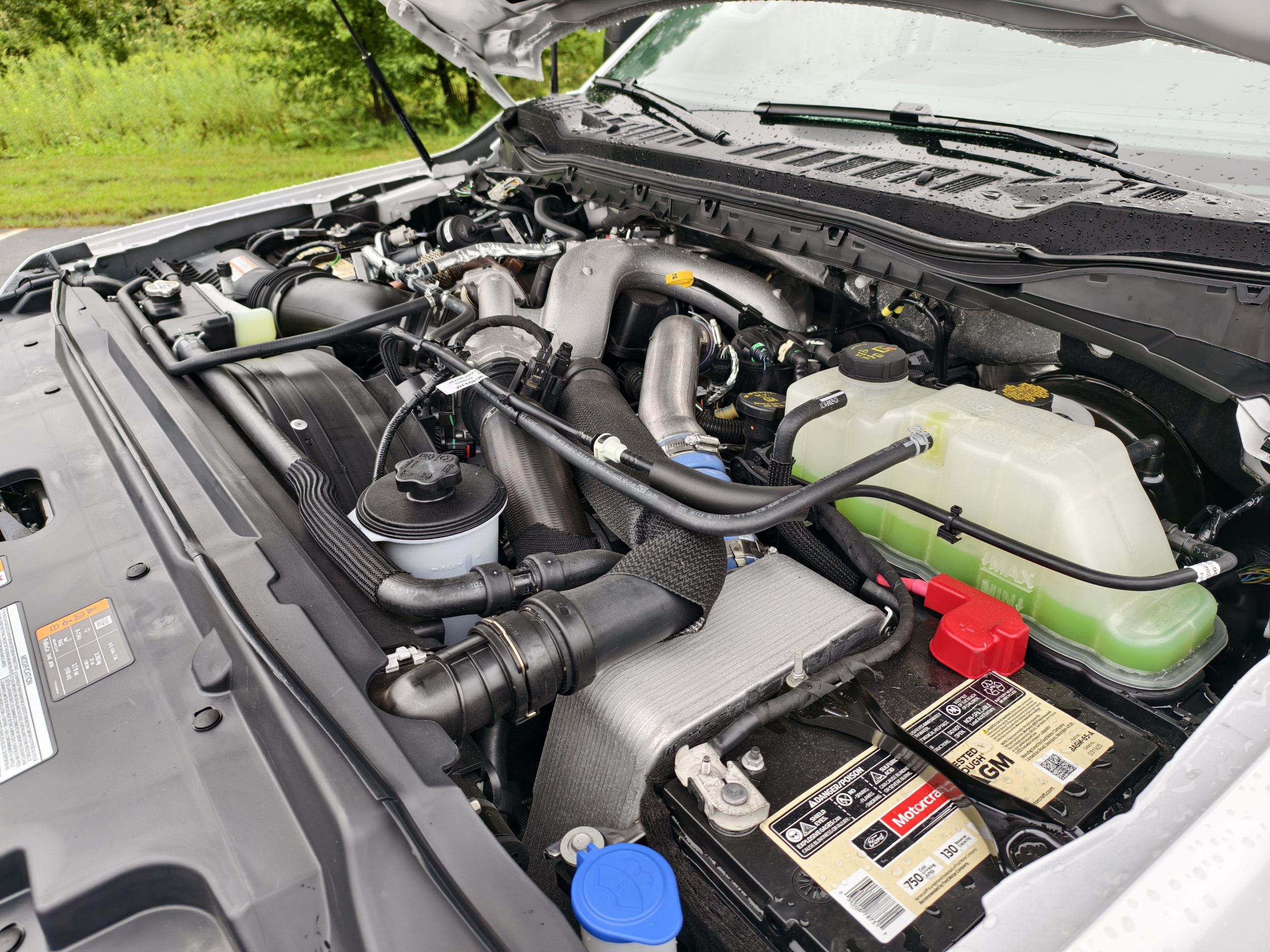
While all of this seems ridiculously excessive, it does make sense. If you’re someone who spends more time in a pickup truck than you do at home, then you would want your truck to be a nice place to be. Working in a trade doesn’t mean that you have to be uncomfortable in the vehicle of your trade. So, a lot of working people will buy a luxury truck because these trucks can still do real work, but also treat you so nicely that you can decompress a little between jobs.
But here’s the thing: These trucks are expensive! The 2025 Ford F-350 Platinum Plus that I tested earlier this year was a whopping $111,310. Sure, my press truck had desirable options, which kicked the price up further, but the base price for a F-350 Platinum Plus is $100,955. The cheapest 2025 Super Duty Platinum Plus is the F-250 at $99,455.

You might remember when I tested a 2024 Ford F-250 Super Duty Lariat last year. The Lariat, which is an upper trim but not a flagship truck, still hit to the tune of $92,520. Sure, that wasn’t the base price — in 2024, a Lariat with no other option than a H.O. Power Stroke was $77,735 — but that’s still nearly $100,000 for a diesel truck.
If you’re working on a tighter budget, or operate a fleet that doesn’t need all of the luxury, getting a base model, the XL, might seem appealing. You’ll save literally tens of thousands of dollars. But how much worse is the base model compared to the flagship? That’s what I sought to find out.
Cheaper, Still Super Duty
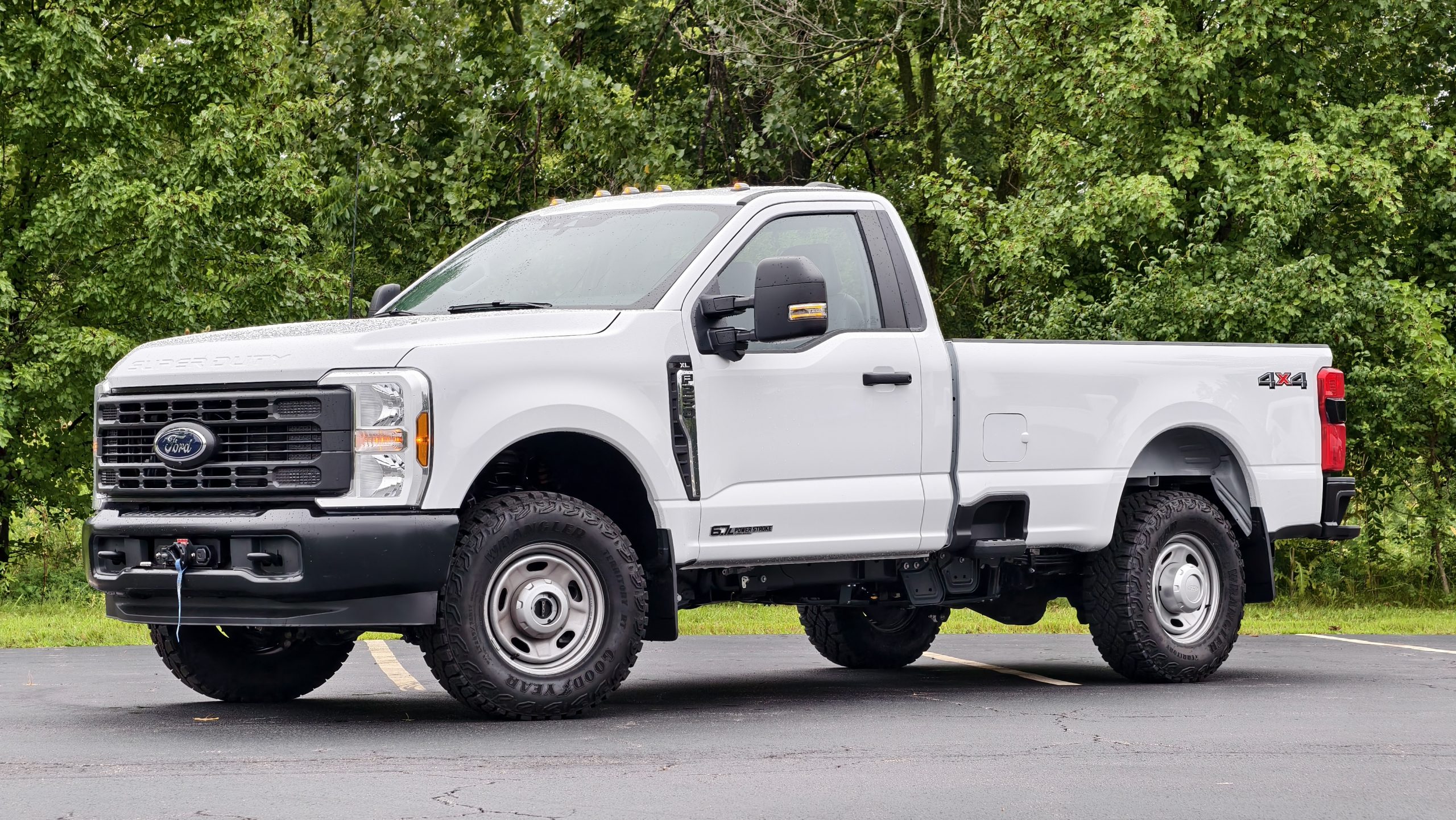
My 2025 Ford F-250 Super Duty XL was an interesting change of pace. Let’s start with the exterior.
Right off the bat, you’ll notice the regular cab, which I wrote a bit of a love story about earlier this summer. While you’ll often find that cheaper trucks will have smaller cabs, that’s not what I want you to pay attention to. Look at the body. This truck is painted in a solid color, doesn’t have running boards, and doesn’t have an inch of chrome. Anywhere some brightwork would appear on a more expensive truck is all flat black metal and plastic here. Wheels? They’re made out of steel and feature the most basic design.
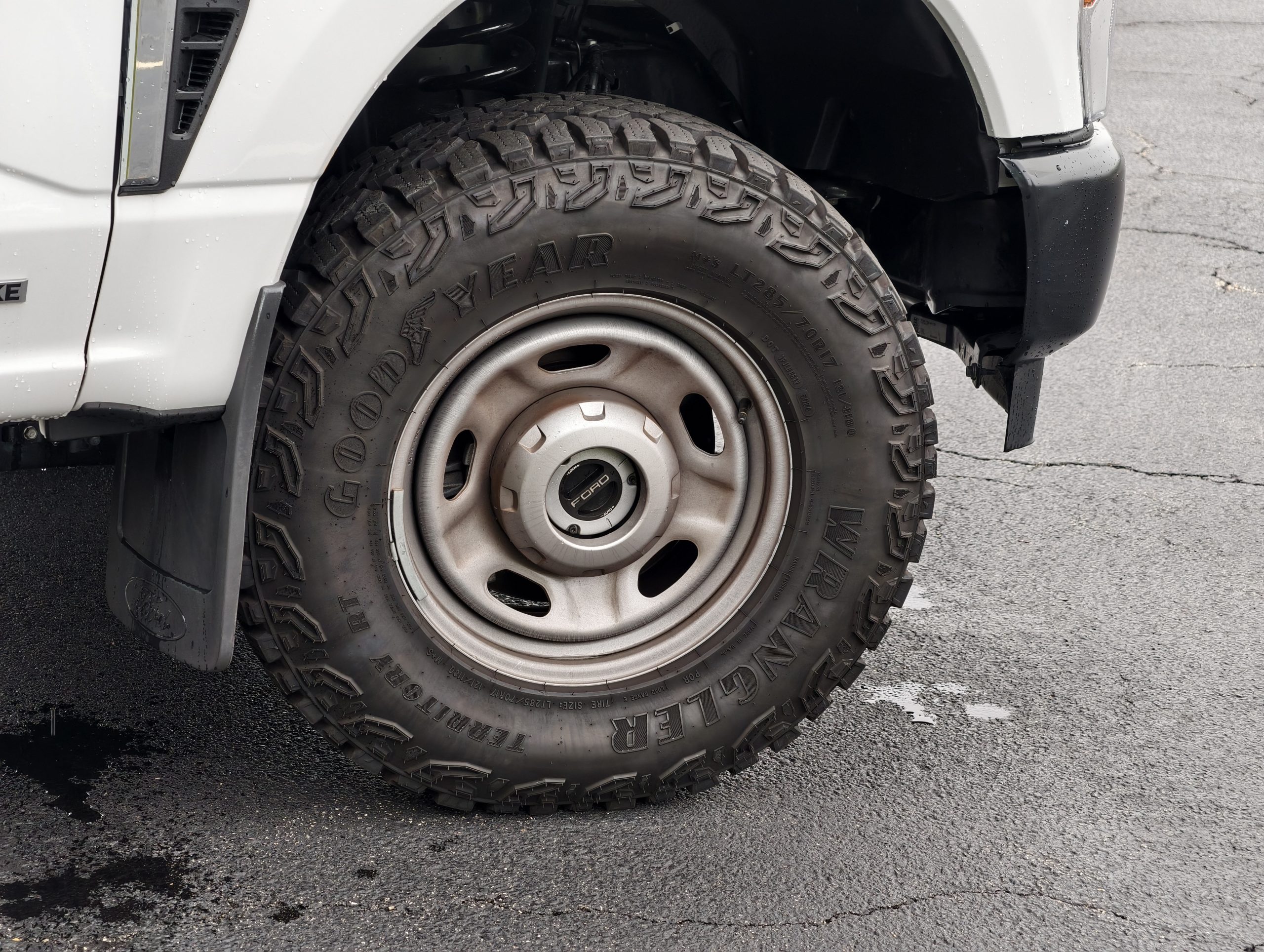
Move around to the back, and the XL’s unapologetic basicness doesn’t change. The rear window doesn’t open and doesn’t have any real tint. The tailgate on the bed? It doesn’t open smoothly, and it isn’t motorized, either. Instead, it readily flops into the open position like the truck tailgates of old. While you’re here, check out the lights on this rig. Note that, aside from the LED clearance lamps, they’re all old-school halogen!
I adore this. There are no frills, no thrills, and no garnish. If you looked up “pickup truck” in the dictionary, a base model F-250 could be the representative photo.
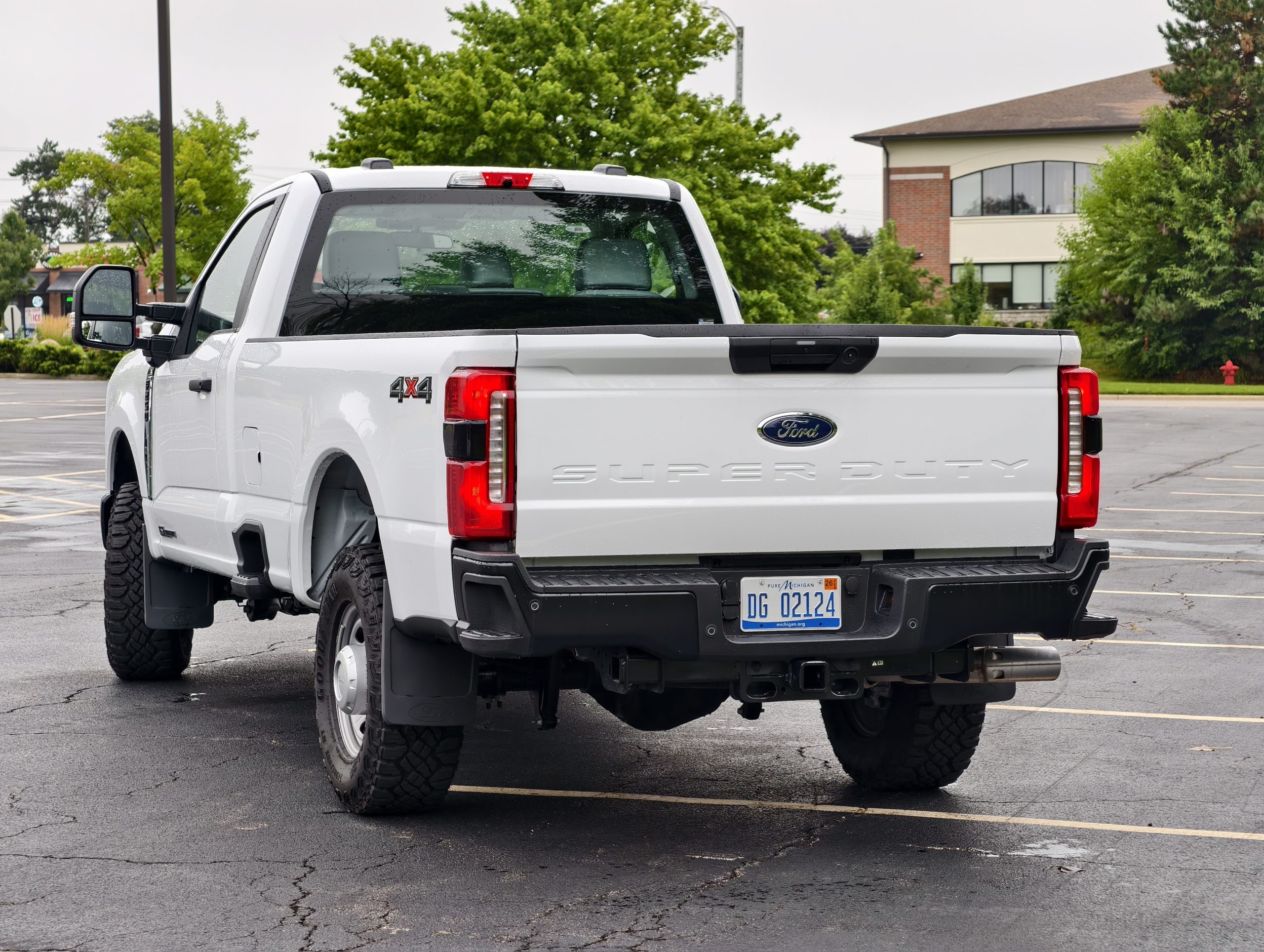
Pop open the cab and it’s much of the same. The cab of the F-250 XL is filled from top to bottom with stiff, hard-wearing plastic.
This is the kind of plastic that journalists would scoff at in a higher trim, but here, I think it’s welcome. Go ahead, kick the door open, get some oil on your fingers, drop some tools into the cubbies, and eat some lunch on the road. This truck interior won’t care. I wouldn’t dare eat a burger in the presence of the suede of the Platinum Plus. But this? The truck would be fine. This is an interior that, if you did make it dirty, a quick run with a wet cloth would dispatch the mess in no time.
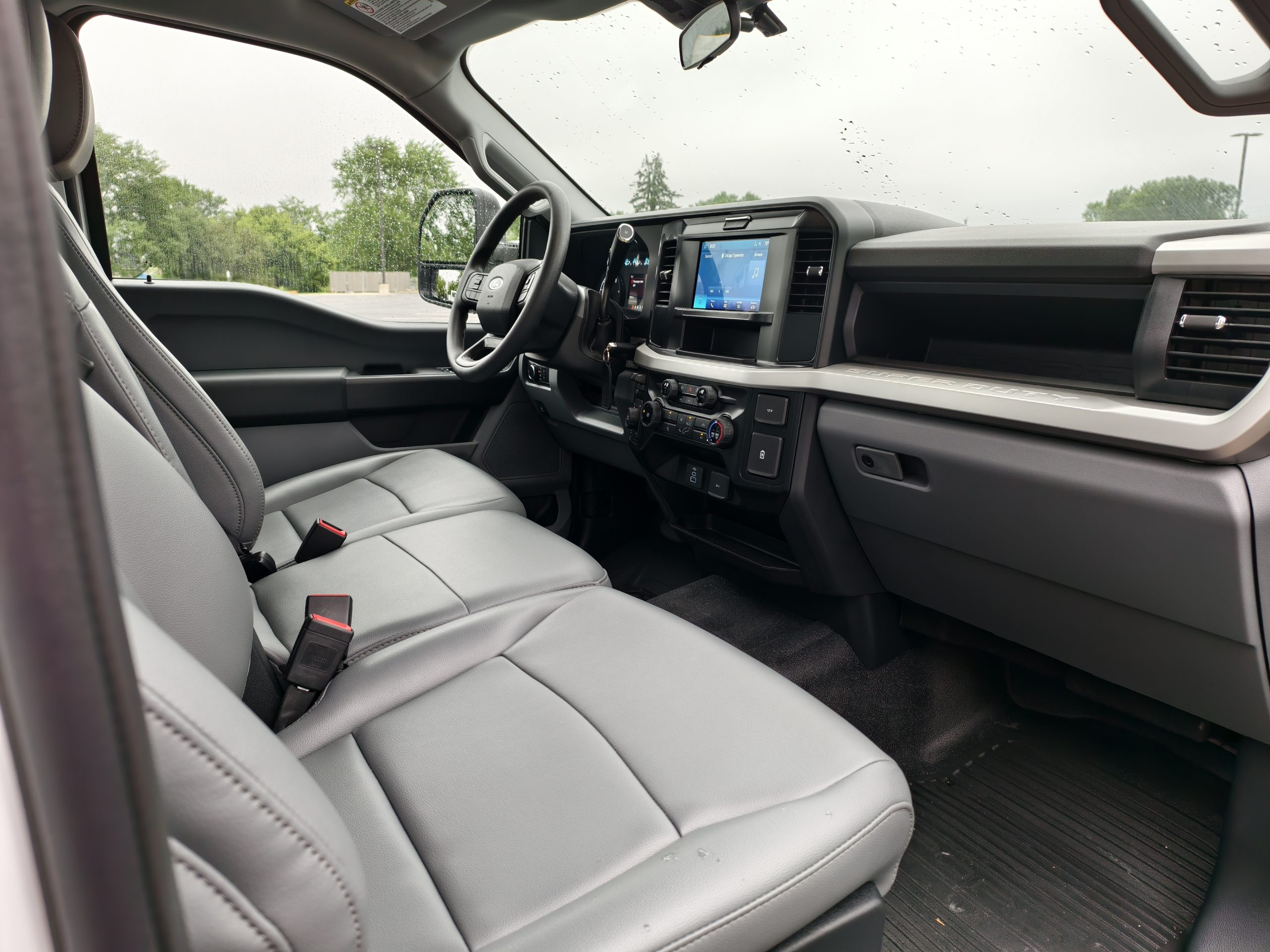
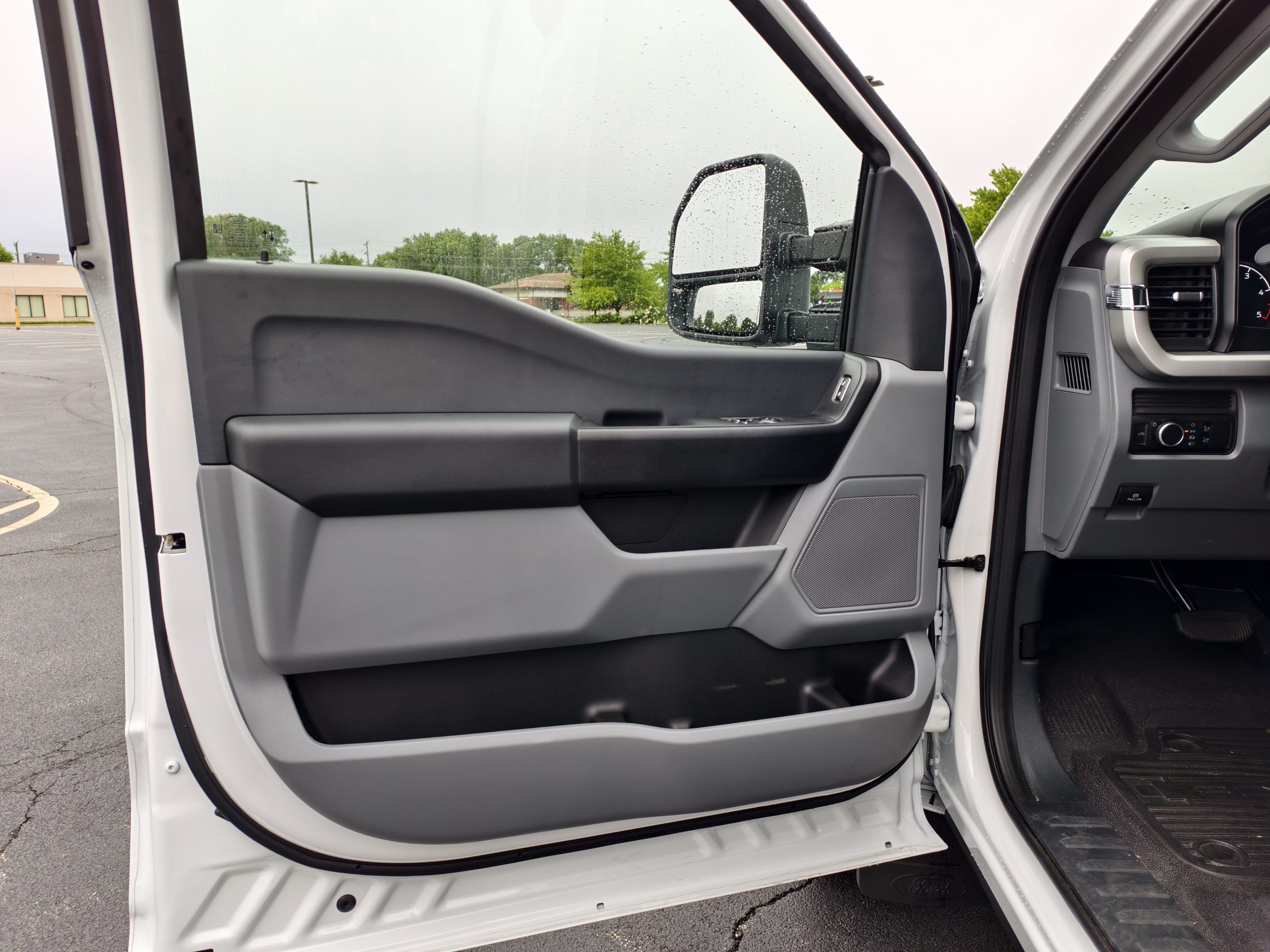
The seat in this truck is Ford’s 40/20/40 bench, which is covered in basic gray vinyl. This bench isn’t a real bench in the traditional sense, but consists of two bucket seats and a center seat that folds into a multifunctional center console.
While I love bench seats, I’m not the biggest fan of this one. The center portion does not recline and does not adjust forward or backward. This is terrible if you sleep in your truck, which is something that a bench seat is normally pretty decent for. The buckets offered no power adjustment, no height adjustment, and only the most basic recline.

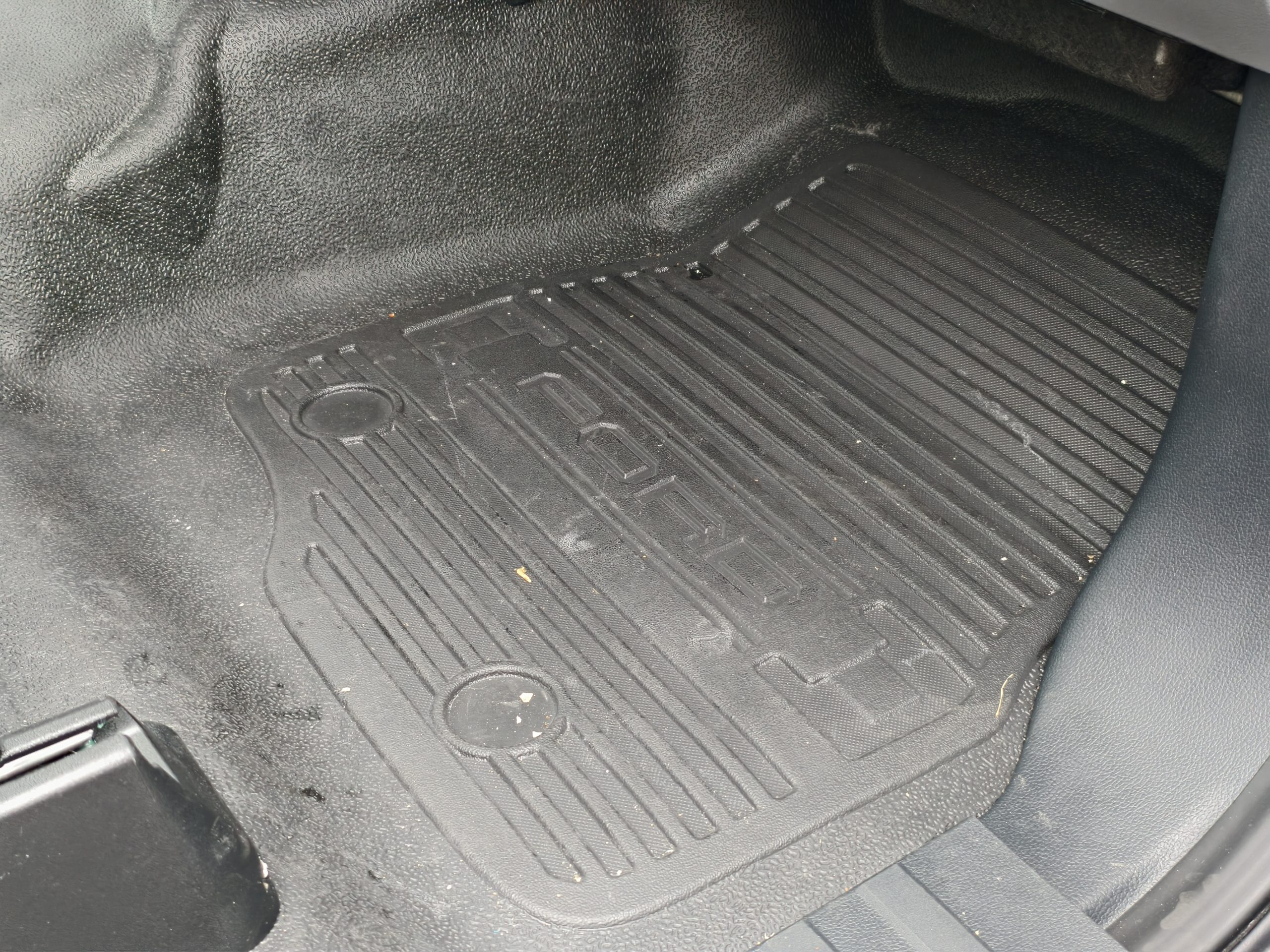
This truck also has a grand total of two proper cupholders, and both of them are on the center console bench portion. Fold the center console into the center seat, and the only way to store drinks in the truck would be to slide them into the door panel pockets, which do not hold large drinks well.
Aside from that, I am a huge fan of this interior. You don’t even get carpet, but a basic rubberized floor. The infotainment screen is barely larger than two phone screens stacked on top of each other, and the instrument cluster features only the tiniest screen with physical gauges. The animations on these screens have low frame rates and again, there’s no sizzle or anything bombastic going on here. Everything is just functional.
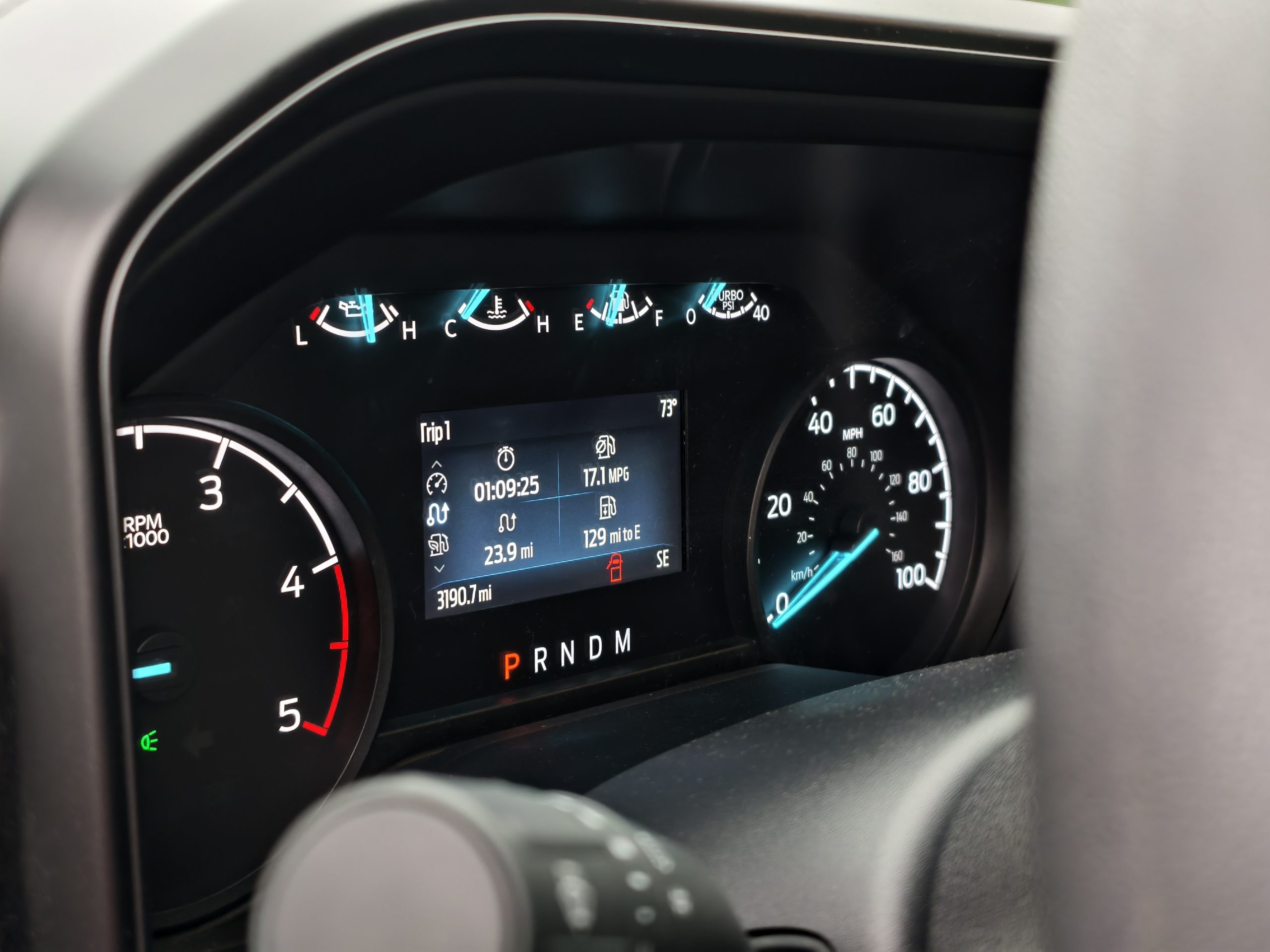

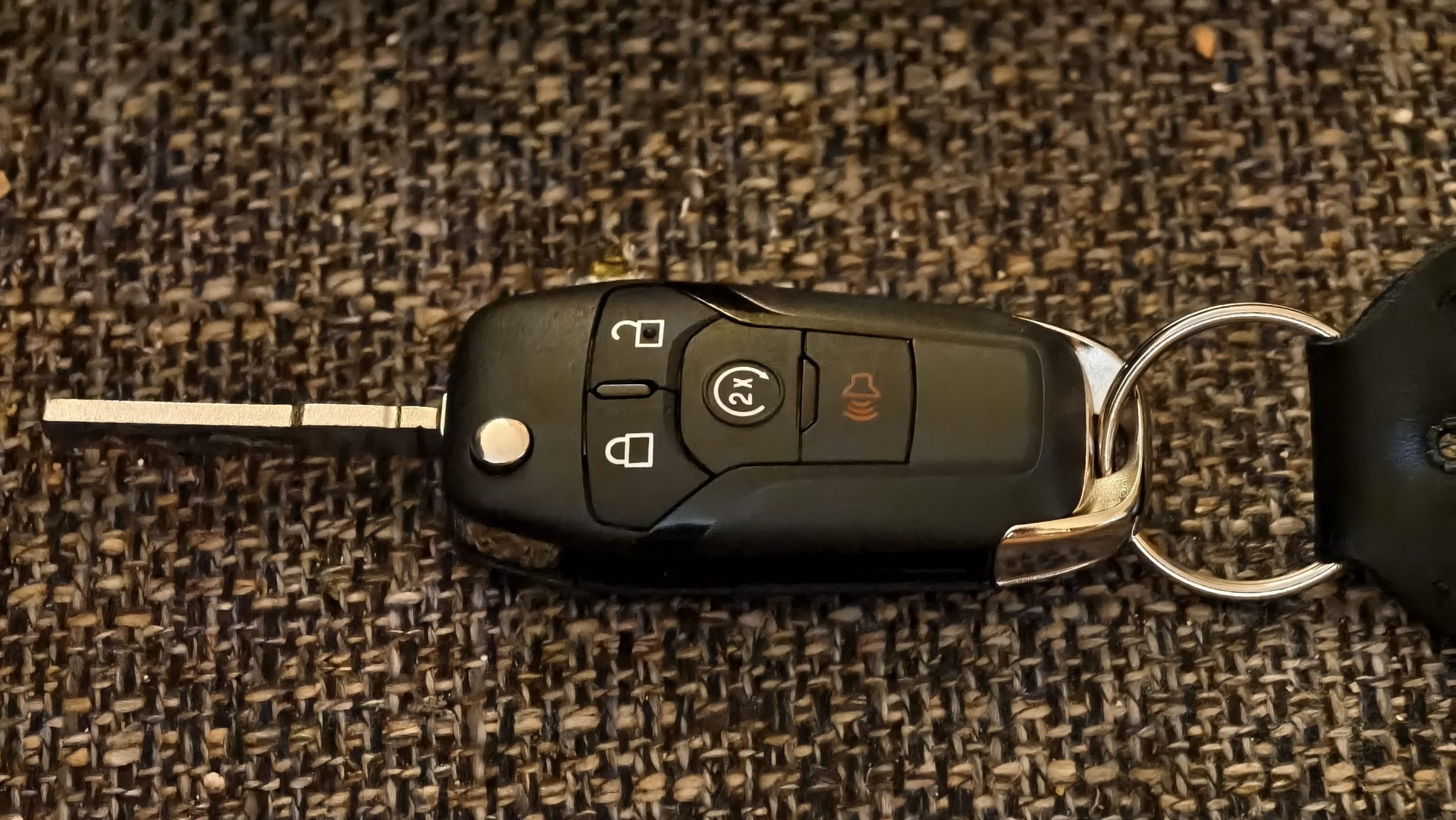
This is further illustrated in the sound system. The one in the F-250 XL is unbranded and doesn’t even have rear speakers. Instead, you get two woofers in the doors and two tweeters in the pillars. That’s it! The last time I drove a new vehicle with a stereo this basic it was a new Smart Fortwo. The audio quality was okay. It wasn’t the clearest, couldn’t handle huge amounts of bass, and flattened out at higher volumes, but it got the job done. Mercedes Jam Session Approved! Also, the infotainment screen still has Android Auto and Apple CarPlay, which is awesome.
Tech is pretty much on the low side. There was no radar cruise control, no active headlights, no passenger screens, no AI-enabled whatever, and not even a keyless ignition. But a welcome change from the base model Super Duty trucks of old is that this one does have a standard cruise control.
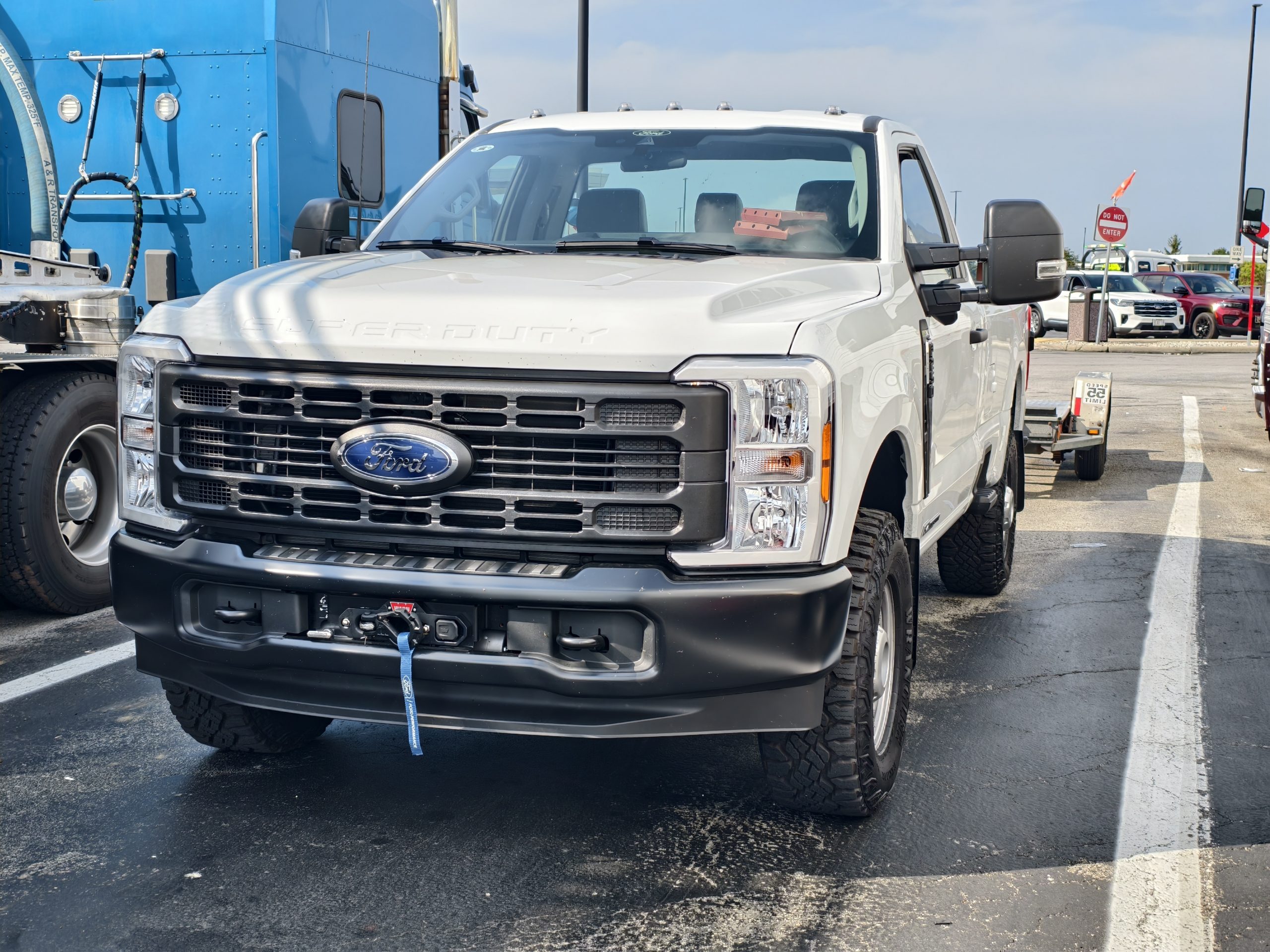
Yep, this truck has an old-fashioned key that slides into a physical ignition. Granted, a modern touch exists in the ignition because it is digital. Just flick the key for a split second, and the truck will start itself, no holding the key in the start position like you would in an older vehicle.
My truck also had some options. The biggest was the XL Off-Road Package, which is designed to give off-roading fans a capable rig in a base model truck. This $995 option piles on chunky 33-inch off-road tires, a locking rear differential, water fording vents, and skid plates. My truck also had a slick winch.
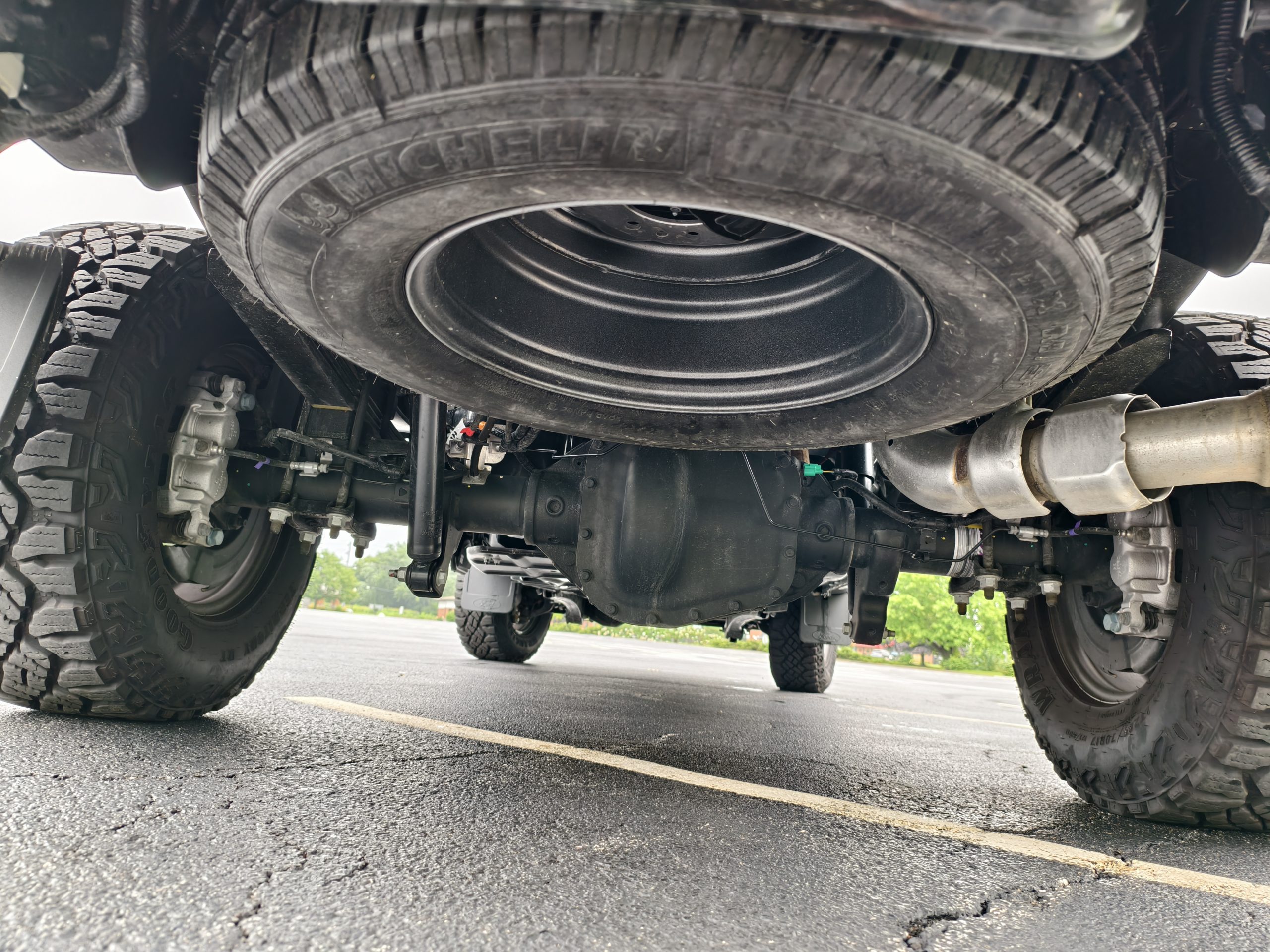

Other options in my tester included Onboard Scales & Smart Hitch ($650), a 360-degree camera system ($1,150), spray-in bedliner ($595), front wheel well liners ($180), splash guards ($130), remote start ($250), high capacity trailer towing ($1,130), tailgate step ($375), 410 Amp alternator ($115), Interior work surface ($140), and a handful of other smaller options.
These options did make the truck feel a touch more high-tech, especially Onboard Scales, which uses the truck’s height sensors to roughly measure payload, and the camera system, but I don’t think they were needed.

Power in this truck came from the standard output 6.7-liter Power Stroke diesel, an $10,495 option, which delivers 475 horsepower and 1,050 lb-ft of torque. It’s backed by 10-speed automatic with a 3.55 ratio rear locking axle.
Let’s Bounce
Alright, so what was this truck like on the road?
In short, this truck was like a time machine back to the trucks of my youth, but with just enough dashes of modernity. There was no technology to figure out or screens to mess with. I hopped in the truck, threw the column shifter into gear, and then hit the road. When it got hot, I used the truck’s many dials and buttons to cool down the cab quickly. It was delightfully old-school.

On the road, I noticed that the power steering in this truck isn’t overly boosted, like I’d find in more luxurious Super Duty trucks. I actually liked the heavy steering. It was a constant reminder that I was driving a heavy pickup truck that towered over bicyclists and people in Miatas. At the same time, I felt that the weight made each turn feel more deliberate.
Once I got used to the steering, I noticed that the suspension of this rig felt like the heavy-duty pickups of old. By that, I mean that this truck jiggles on every single bump. I used to say that some vehicles have a suspension communicative enough to tell you when you’ve run over a coin and what face is printed on that coin.
Well, this truck is the exact opposite of that. Hit even a mild bump, and the suspension will send a shock through the truck that bounces your chest, makes the dash shake, and jiggles the bed. It’s pretty common knowledge that heavy-duty trucks have rougher suspensions, especially when unloaded. I remember some journalists complaining that the new Ram HDs had bouncy suspensions. I invite those guys to take a ride in this F-250, because it’ll reset their baseline for rough and make those Rams feel like Cadillacs.

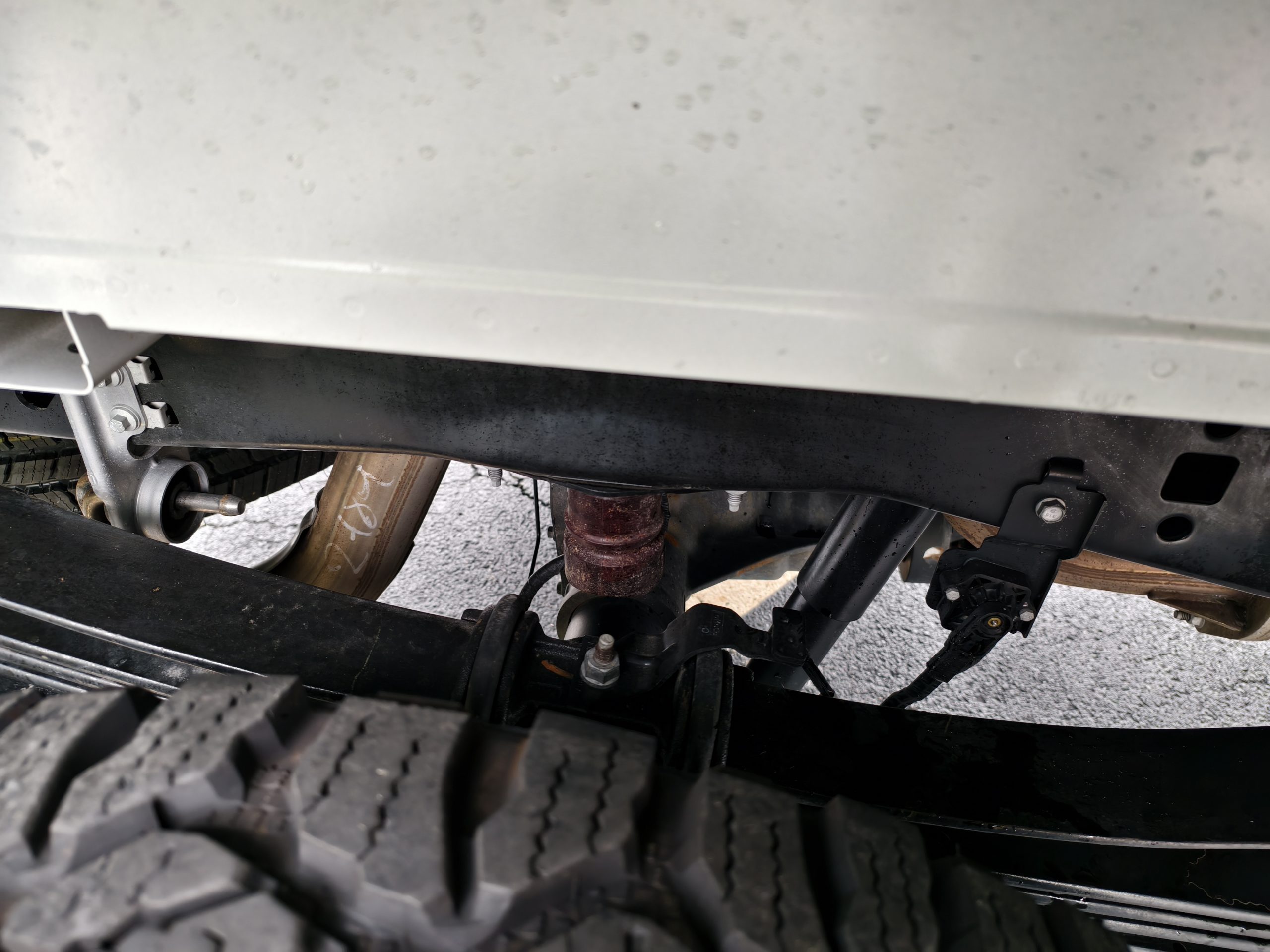
I place part of the blame on the off-road package, but it’s also just the fact that this truck isn’t working very hard to provide comfort to its occupants. It is not a Platinum Plus or a Lariat. I wouldn’t say that the rough suspension rises to the level of causing any harm, any danger, or any control issues. But this F-250 is extraordinarily bumpy when unloaded. At least the vinyl seats, despite not being nearly as super cushy as the Platinum Plus seats, do an admirable job of soaking up the bumps.
Personally, I thought the suspension was great fun, even if it wasn’t comfortable. Again, it reminded me of the heavy-duty pickups of old, which happily exchanged your comfort for carrying capacity.
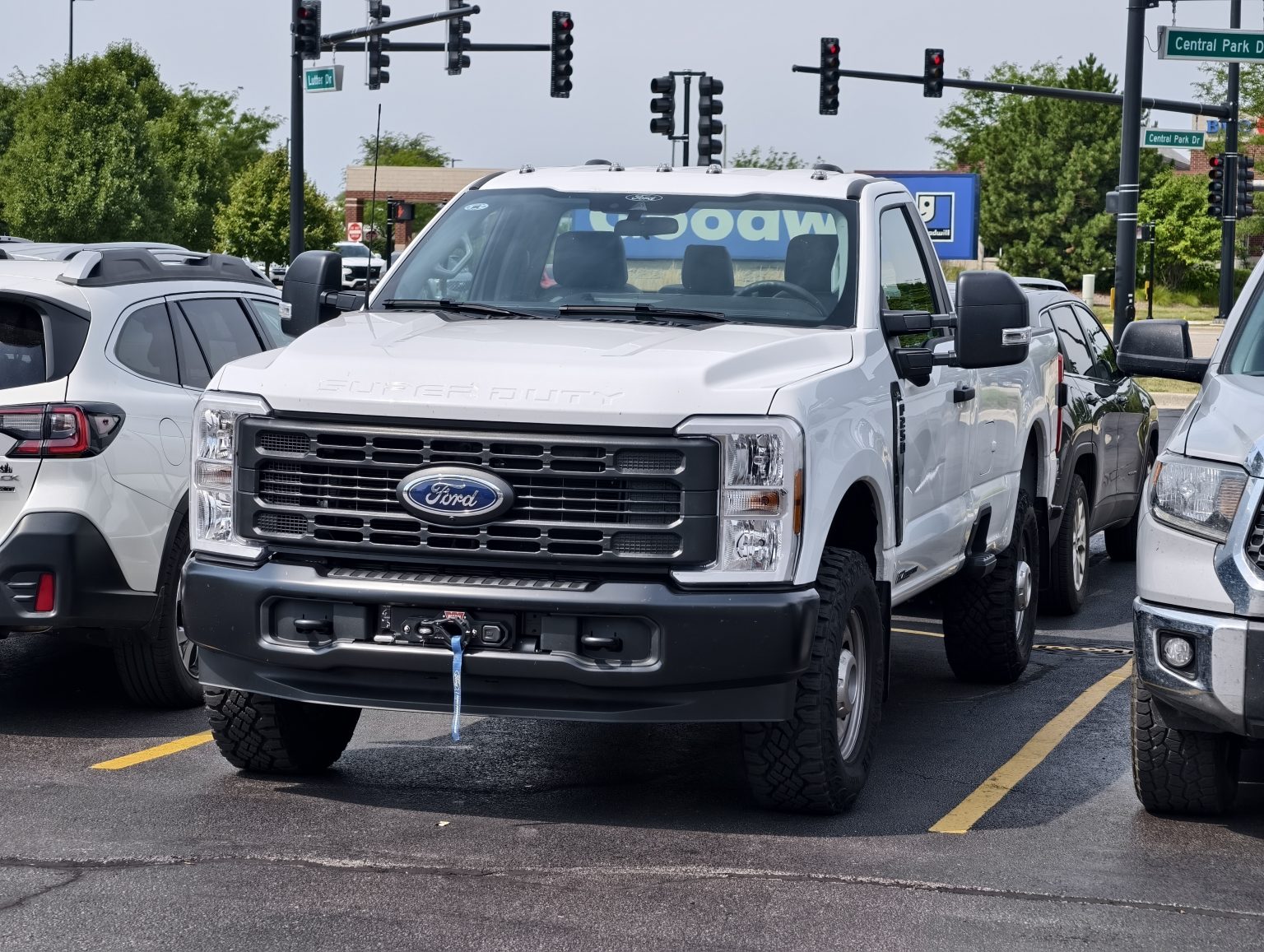
As I wrote earlier this summer, this F-250’s regular cab configuration had several benefits. It navigated my neighborhood more easily than the F-250 Lariat from last year and the F-350 Platinum Plus from earlier this year. The truck also mostly fits into normal parking spaces. I also adored the rearward visibility, as there was just a window directly behind my head, and not a row of seats and then a window feet away.
In practice, this meant that living with the F-250 as a daily driver was easy. I didn’t have to park in the back of the grocery store parking lot, I easily fit into drive-through restaurants, and I didn’t have to park the truck in the overflow lot at the apartment complex that I live in. The truck even scored 20 mpg around town, which wasn’t bad given that this was still a heavy-duty diesel pickup truck.
On A Road Trip

On the highway, the truck made for a good road trip companion. Loading the U-Haul Auto Transport onto the back, which weighs 2,210 pounds, did make the suspension a touch softer, but it was still rough. On the highway, the truck scored above 18 mpg when empty and about 17.4 mpg with the empty U-Haul on the back. It then averaged about 16 mpg with the car on the back. Keep in mind that trailer aero matters more than trailer weight, and a 1998 MGF is more aerodynamic than the typical vehicles that I import from Japan or pull out of a random forest.
What I loved about the F-250 XL on a road trip is that, while I was not as comfortable as I was in the Platinum Plus, it was an even easier time. There were far fewer tech distractions, and I felt comfortable drinking a nice lemonade without worrying about what would happen if I spilled any on the seat. I didn’t have to worry if my bright LED headlights were blinding drivers because it didn’t even have LED headlights. I felt comfortable putting a couple of tools in the cab with me. I also liked how, thanks to the rubber floors, cleaning the footwells out was as easy as brushing them out with my hand or a broom.
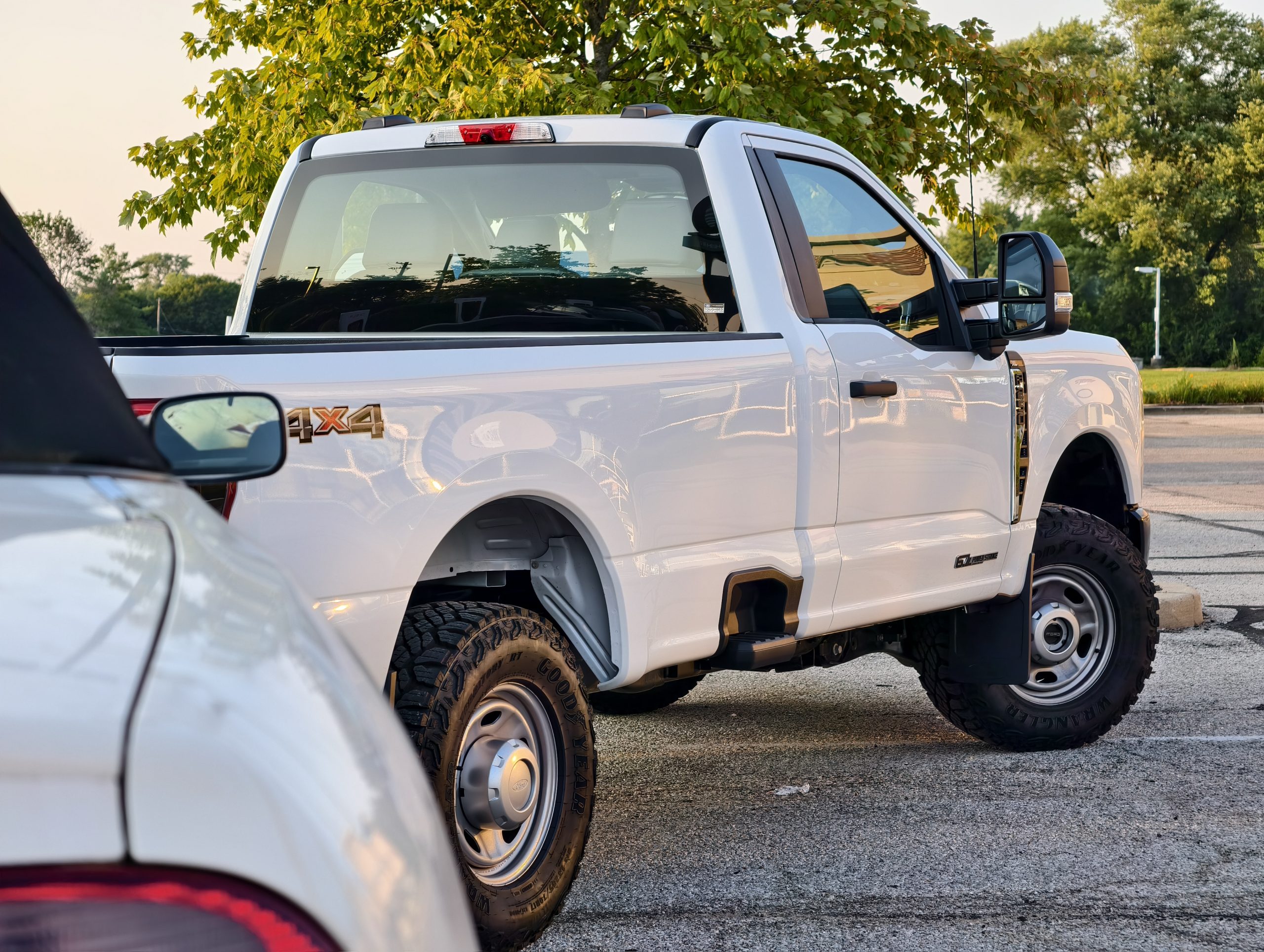
This was a great truck to use for hauling a car. You could feel that the standard Power Stroke has less power than the High Output model, but these diesels already make so much power that even the standard version punches harder than you may ever need. This truck will happily light its rear tires or climb through Appalachia with a car on its back without downshifting from tenth gear. The fifth-generation Super Duty makes towing a cinch, and getting the standard Power Stroke doesn’t change that one bit.
One part of the truck was a little bit of a letdown. While sleeping in the Platinum Plus was some of the best sleep I have gotten in any vehicle, sleeping in the F-250 XL was actually some of the worst sleep. The vinyl bench gets all hot and uncomfortable when you’re trying to sleep, and since the bench isn’t a real bench, the bolsters of the buckets try to jab you and the immovable center seat gets in the way. But, I suspect most people get hotels when they’re on road trips, so ignoring this is easy. When you aren’t trying to sleep on it, the seats are fine. They’re not cushy, but they also don’t hurt or anything after a long day of driving. They’re just seats.
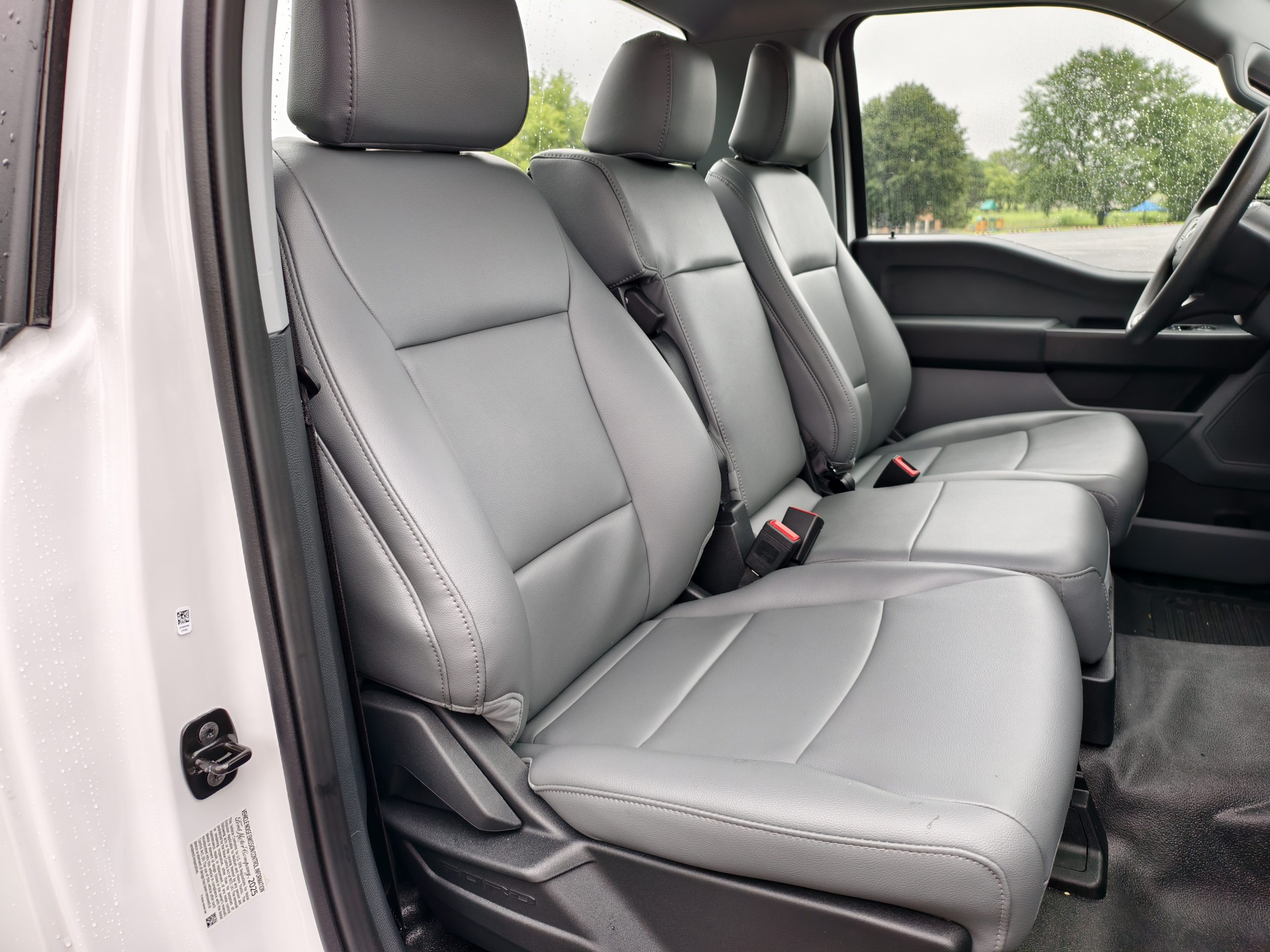
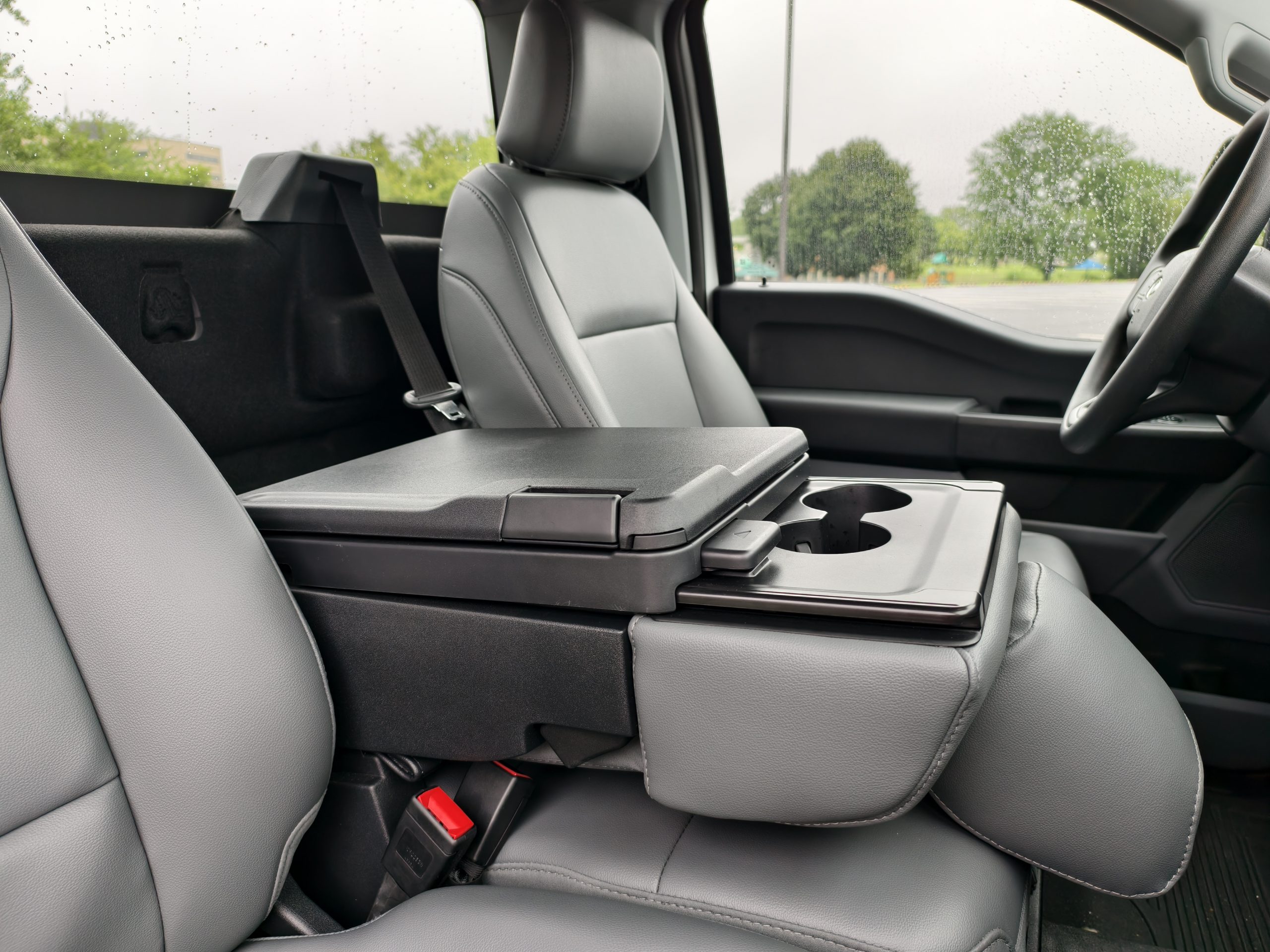
This time, I am also happy to report that this truck had zero fit and finish and zero quality issues of any kind. The truck worked every time without a complaint, an error, or anything of the sort. I was even able to sneak in some fun in the dirt with the truck, too. Heavy-duty pickup trucks are a bit weird in how well they off-road despite their sheer girth, and this F-250 was no exception. Sadly, I did my trip during a dry spell, so I couldn’t find any obstacle soupy enough to even come close to get the truck stuck, but it was entirely unbothered by the basic trails that the Midwest tends to have.
In the end, I drove the F-250 XL just a touch under 2,000 miles, with most of those miles being towing.
Base Models Can Be Awesome
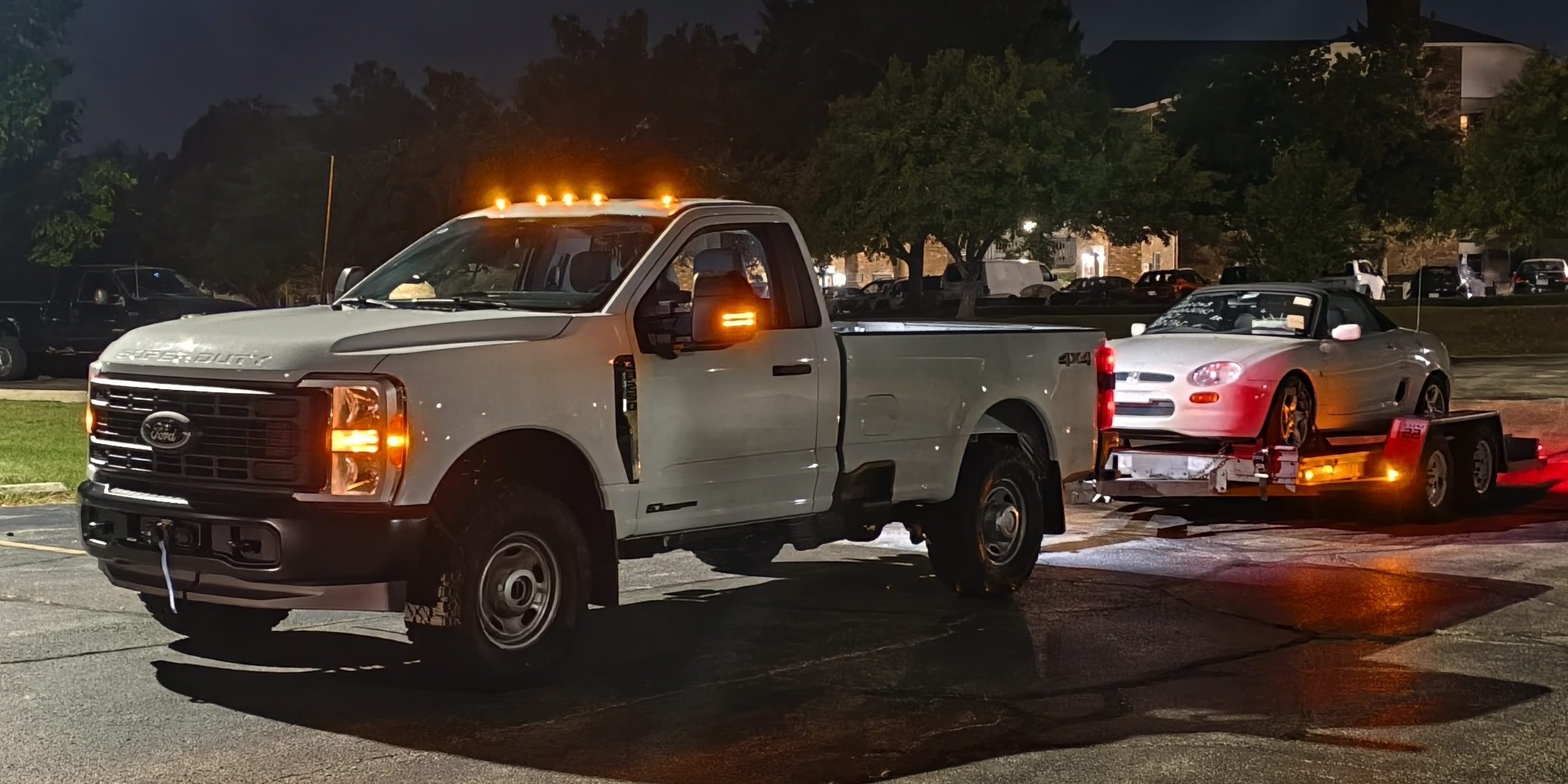
I came out of the other side a bit surprised. The 2025 Ford F-350 Super Duty Platinum Plus was, without question, one of my favorite new trucks of all time. Yet, the 2025 Ford F-250 XL was great, too, but in its own way. I didn’t constantly worry about ruining the XL’s interior, and it was refreshing to have so little tech that the average driver could easily get by without reading the manual. It’s a truck that you can carry tools in or eat lunch in without guilt, and in a worst-case scenario, you can broom the shame away, anyway!
Of course, the biggest reason to go with a truck like this is to save money. My tester, which came with all of the options I noted above, was $74,675, or close to $40,000 cheaper than a Platinum Plus. You can get one of these bad boys for even cheaper, too. The absolute cheapest diesel truck that you can buy from Ford right now is a 2026 Ford F-250 Super Duty XL 4×2 Regular Cab. This has a base price of $45,675. Add in the $10,995 standard output Power Stroke, plus a $2,595 destination charge, and you’re at $59,265. Toss on a 4×4 system and the off-road package, and you’re at $63,050.
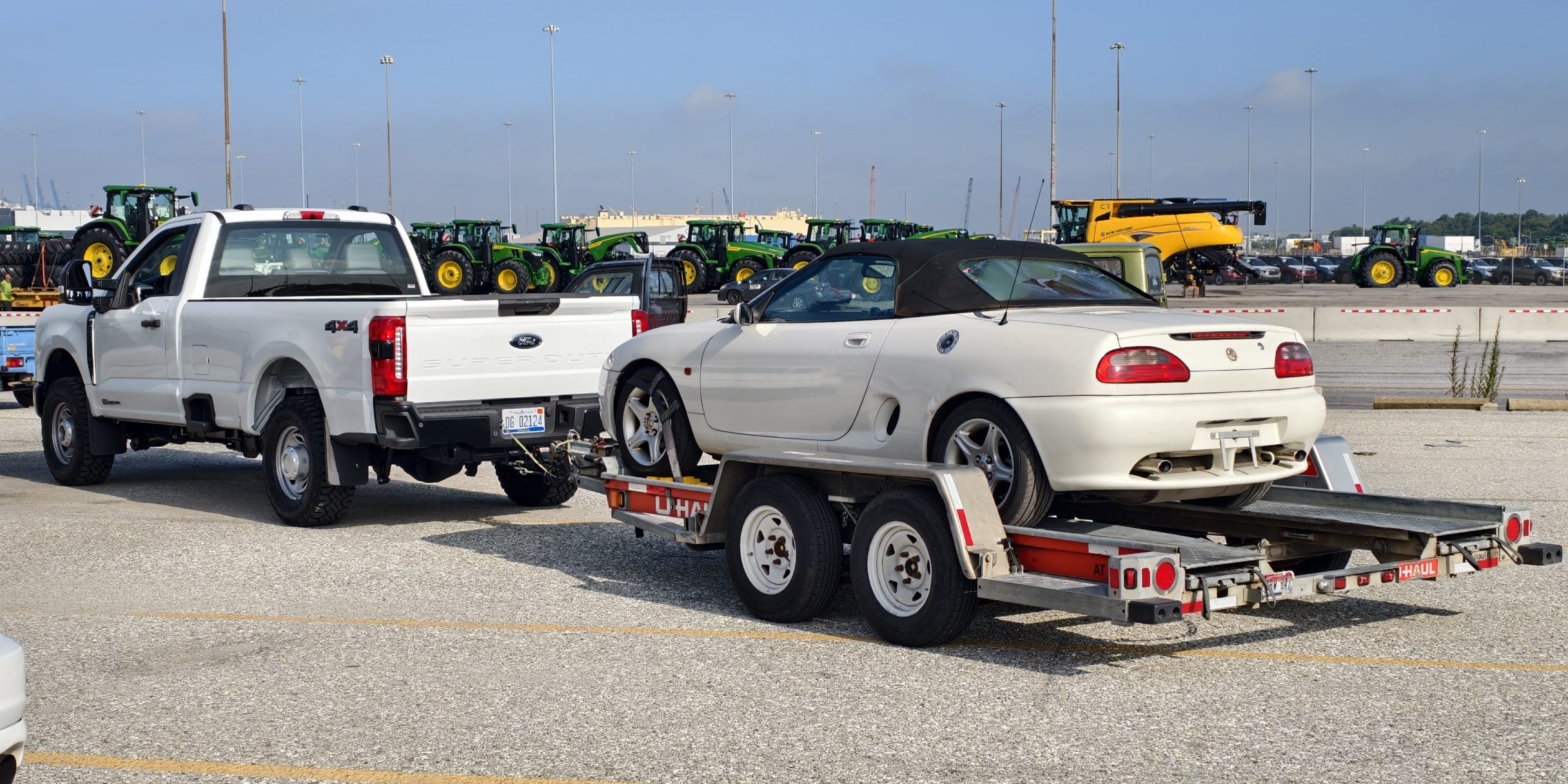
The F-250 is not the cheapest diesel truck in America, that distinction belongs to the 2026 Chevy Silverado 1500 LT with the 3.0-liter Duramax, which costs $56,840. But it’s also not much more expensive! What’s interesting is that, in a truck like this, you’re paying mostly for the powertrain, chassis, and capability. You also might not even pay this much, as a dealer might be willing to throw some cash on the hood to move a base model truck.
For me, this truck taught me that even base models rock. It’s the exact opposite of the Platinum Plus, yet it doesn’t suck. If you don’t need all of the flair and chrome, go with a base model, and I bet you’ll be happy. You’ll get all of the great parts about a Super Duty, and maybe save some money doing it. If you spec it out to $74,000 like my tester was, you’re paying luxury car money for vinyl seats and plastic everything. But for some, being able to tow 20,000 pounds like it’s nothing will make the cost worth it.
Top graphic image: Mercedes Streeter

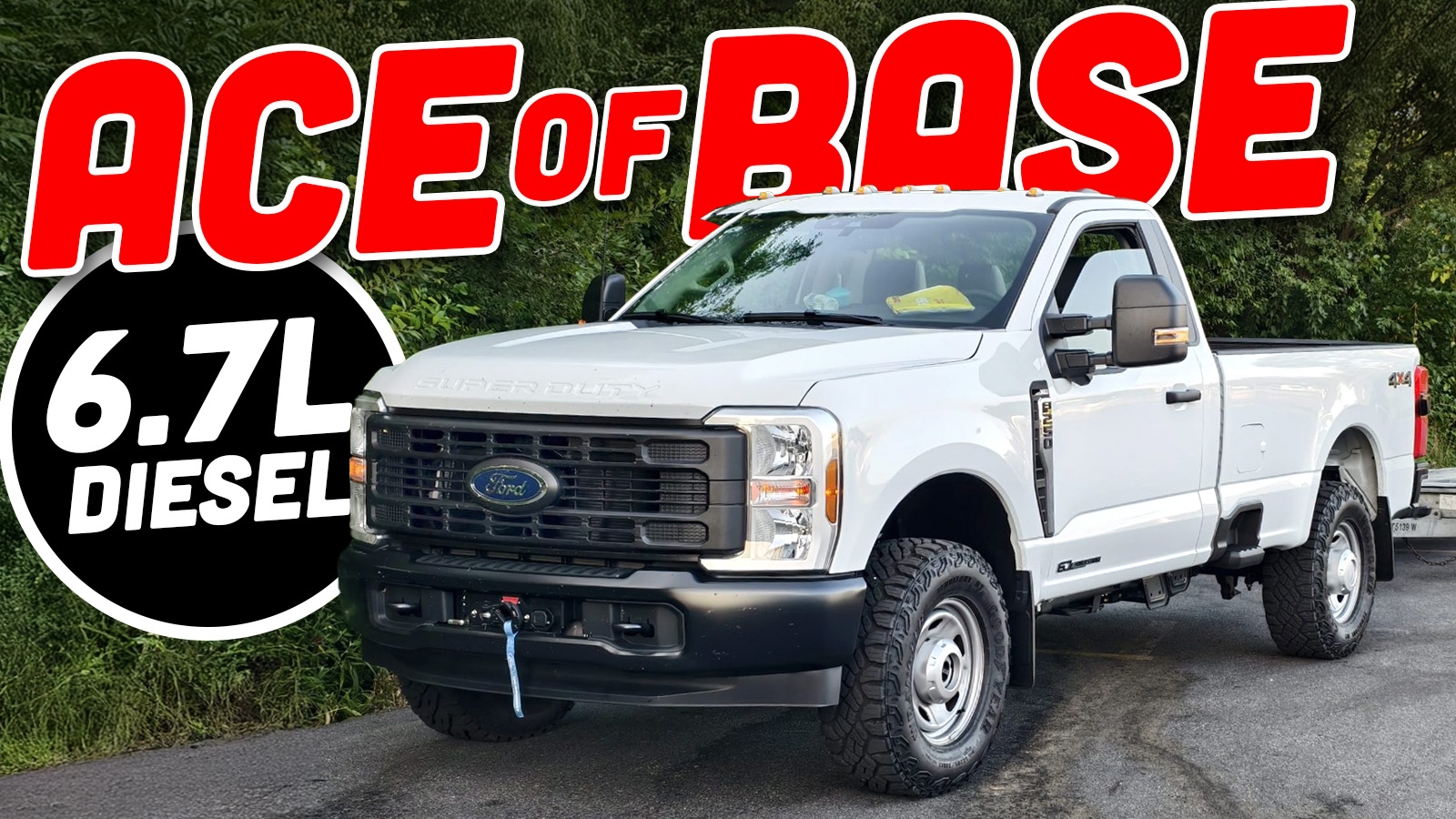




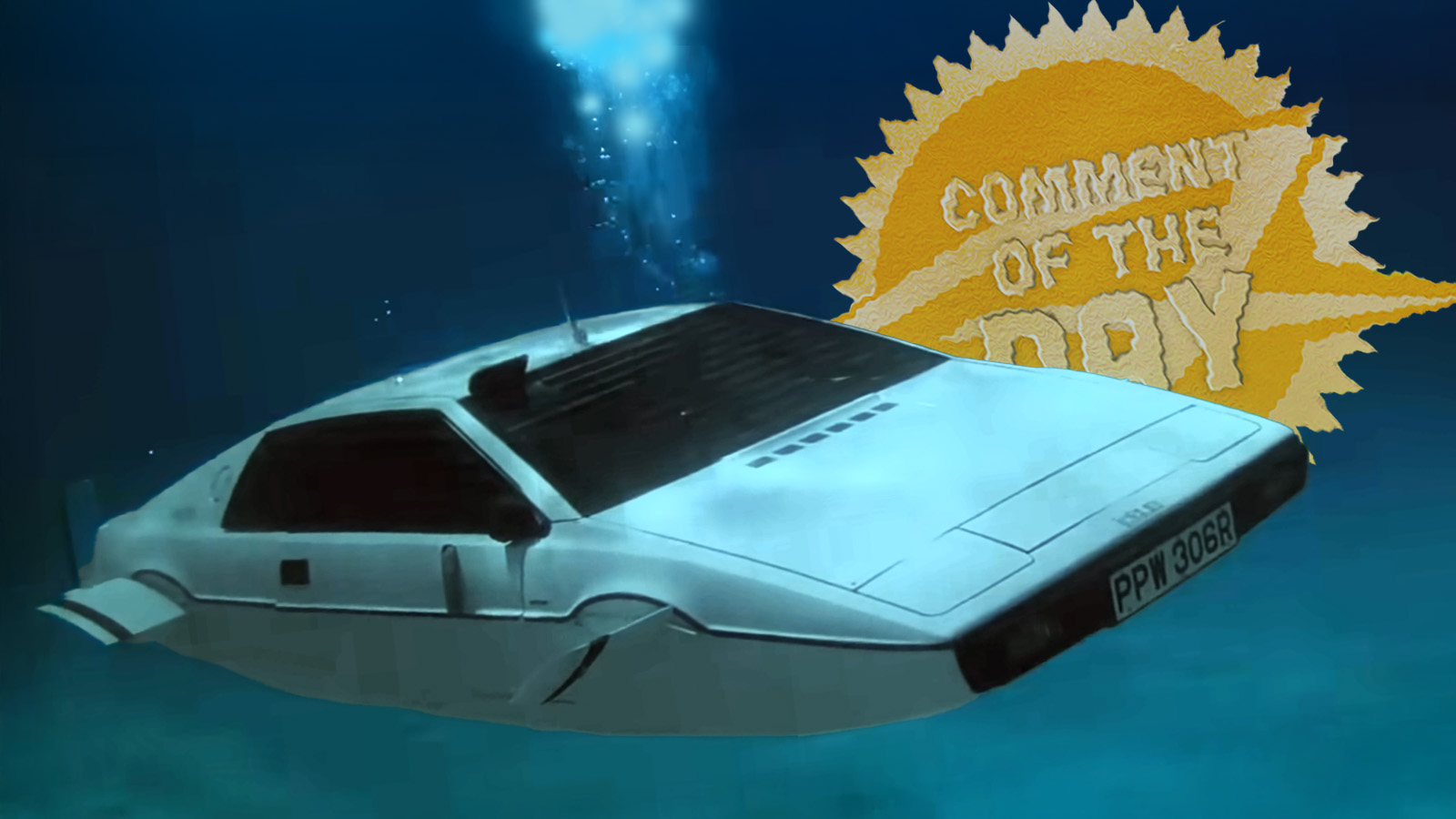


Too expensive.
My personal pick: Used 2500 HD Vortec 6.0L L96. Transmission isn’t as good, the truck is built way cheaper, but I feel it will be easier to work on (minus the oil pressure sensor location).
Last thing I expect is this base model to be included in a recall. With all the QC issues everyone has (grenading engines, valve body problems, electrical issues) , I believe it would be wise to add an extended warranty.
That’s a lot of money for a low-content, albeit capable, HD truck, diesel notwithstanding.
That said, something about the aggressive Goodyear Duratracs on plain steelies on this truck just looks so good.
A base model with $10K in add-ons and it felt good. Feels like the headline doesn’t quite line up here. I agree with the premise of the article and it was a good read, but the headline is a bit misleading.
These trucks are obviously oriented towards trades and fleet operators, and they’re great for those uses. Nearly all the Super Dutys I order are low-content XLs. It doesn’t matter how good the seats are for sleeping, because no one is going to lie down and sleep in it. But you do need to be able to install a full-length aftermarket console, or a short radio console ahead of the factory seating, and the fixed 20% center makes this easy. I do order them with power seats because that makes it easier for drivers who are short women to get a good driving position. Non-fob keys are harder to lose, and much cheaper to replace when you need to replace one. Also, per ManwichSandwich, we largely avoid diesels for that very reason. All of our trucks see exclusively city use and it makes maintenance a PITA.
I requested this before, but how does it do when you chuck the key out the window on the freeway and leave the windows down during a thunderstorm?
(sorry I still think this is like the funniest shit ever lmao)
“Power in this truck came from the standard output 6.7-liter Power Stroke diesel, an $10,495 option, which delivers 475 horsepower and 1,050 lb-ft of torque.”
Geez… 475hp for the “standard output”… which sounds like overkill to begin with.
One thing of note, modern diesels can be a terrible option if you mainly do short trips… because doing that on a modern diesel will clog up the EGR with soot in no time because it won’t have time to do a proper ‘regen’.
The diesel is best used for cases where you drive it hard/harder by towing regularly and you drive for at least an hour every time you drive it.
Otherwise, you’re better off with the cheaper gasoline engine.
I test drove an even more base one back in the spring. Although it was a crew cab (I have kids), it didn’t have any of the fancy add ons that this truck had, and was powered by the 6.8 gas engine. I liked it quite a lot. I drive old cars, and when I’ve rented modern cars with huge screens and all the beep-boops, I’ve always found them overwhelming and completely turned off by it all. That F-250 just had a small screen, a real key, and regular gauges. If I was going to buy a new truck, I’d get that. I was turned off by the advertised price being MUCH lower than what they tried to sell it for. Even the advertised price would have been a real stretch. I’m just going to keep my trusty ’06 Sierra.
When the time comes, I’m going to seek out a 2wd model. They’re lower, and modern trucks are just stupidly tall. Hilariously 2wd Super Duties still use the old twin I-beam suspension.